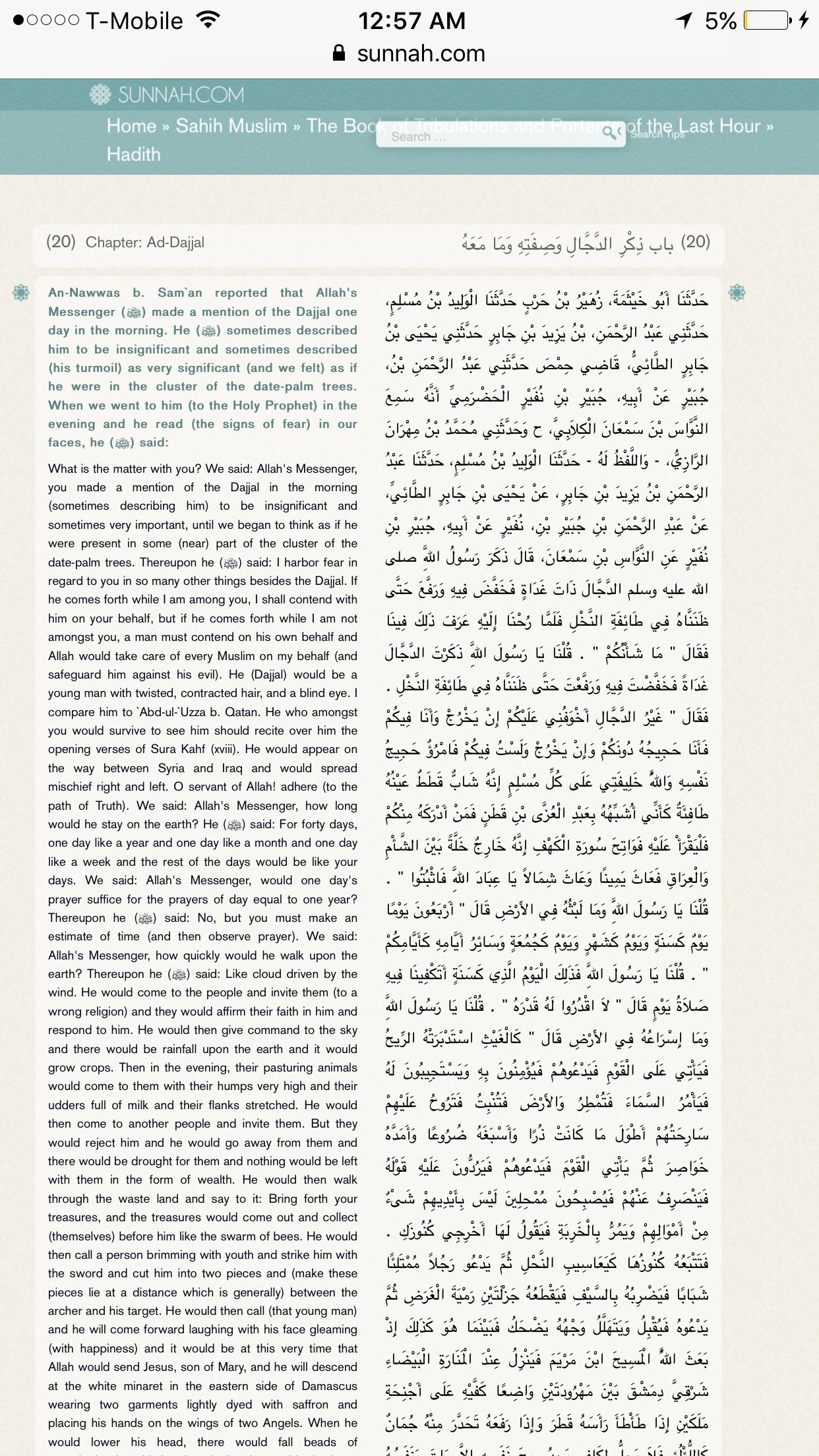
Here's an analysis of the Dajjal, drawing upon various Islamic sources.
The Dajjal: An Overview
According to www.iAsk.Ai - Ask AI:
The Dajjal, also known as Al-Masih ad-Dajjal, is a significant figure in Islamic eschatology. He is described as an evil being who will appear before the Day of Judgment, claiming to be the promised Messiah and later, God.[1] The Dajjal is not mentioned in the Quran, but his characteristics and actions are detailed in the Hadith.[1] He is often compared to the Antichrist in Christianity.[1]
The Killing of the Dajjal
The Dajjal's emergence is often associated with the East, though the specific location varies in different accounts.[3] He is typically described as having a physical deformity, such as being blind in one eye.[3] The Dajjal will perform miracles that resemble those of Jesus, such as healing the sick and raising the dead, but these are said to be done with the aid of demons.[3] He will deceive many people, including Jews, weavers, magicians, and children of fornication.[3]
The Dajjal will be killed by Isa (Jesus) at the gate of Lod. [3]
The Hadith indicates that the Dajjal will be killed by Isa (Jesus). According to Sunni Hadith, Isa will descend near Damascus and then pursue the Dajjal to the gate of Lod, where he will be captured and killed.[3]
The Nature of the Dajjal's Defeat
The Role of Arguments
The Ahmadiyya Muslim community interprets the Dajjal as a system or group of nations rather than an individual.[33] They believe the Dajjal represents the expansion of European Christianity and colonialism.[33] The Ahmadiyya view emphasizes that the Dajjal's defeat will occur through intellectual and spiritual means, specifically through the advent of the Messiah and the spread of Islamic ideals, rather than through physical warfare.[42]
The Gate of Ludd
The Hadith indicates that the Dajjal will be defeated through arguments. The term "contend" (حَجِيجُهُ) is used in the context of the Dajjal, meaning to argue or debate.[3] This suggests that the Messiah will overcome the Dajjal through intellectual and spiritual means.[3]
Conclusion
Isa (Jesus) will play a crucial role in defeating the Dajjal. He will descend from the heavens and pursue the Dajjal to the gate of Lod, where he will be killed.[3]
The Role of Isa (Jesus)
The "gate of Ludd" (Bāb al-Ludd) is the location where the Dajjal will be killed. The word "Ludd" (لُدّ) in Arabic is associated with contention and argumentation.[3] This further supports the idea that the Dajjal's defeat will involve intellectual and spiritual confrontation.[3]
The Dajjal's defeat is a complex event with multiple interpretations. The most authoritative sources indicate that the Dajjal will be killed by Isa (Jesus) at the gate of Lod. The Ahmadiyya Muslim community interprets the Dajjal as a system and believes that the defeat will occur through intellectual and spiritual means.
Authoritative Sources
- Farhang, Mehrvash (2017). "Dajjāl". In Madelung, Wilferd; Daftary, Farhad (eds.). Encyclopaedia Islamica. [Encyclopaedia Islamica]↩
- Siddiqi, Shazia (17 January 2020). "The Antichrist of Islamic tradition". [Olean Times Herald]↩
- Cook, David (2021) [2002]. Studies in Muslim Apocalyptic. [Gerlach Press]↩
- Wahiduddin Khan (2011). The Alarm of Doomsday. [Goodword Books]↩
- J. Payne-Smith (1903). A Compendious Syriac Dictionary. [Clarendon Press]↩
- Lewisohn, L., Shackle, C. (2006). Attar and the Persian Sufi Tradition: The Art of Spiritual Flight. [Bloomsbury Publishing]↩
- https://www.cgie.org.ir/fa/article/240697/%D8%AE%D8%B1-%D8%AF%D8%AC%D8%A7%D9%84↩
- "Sunan Abi Dawud 4321". [sunnah.com]↩
- "Sahih Muslim 2937a - The Book of Tribulations and Portents of the Last Hour - كتاب الفتن وأشراط الساعة - Sunnah.com - Sayings and Teachings of Prophet Muhammad (صلى الله عليه و سلم)". [sunnah.com]↩
- "Sahih Muslim 2937a". [sunnah.com]↩
- "Sunan Ibn Majah 4077". [sunnah.com]↩
- "Sunan Abi Dawud 4294". [sunnah.com]↩
- Sahih al-Bukhari, 9:88:237↩
- Gallagher, Eugene (28 February 2020). "Millennialism". [Oxford Research Encyclopedia of Religion]↩
- Persian shawls↩
- "Sahih Muslim - Arabic-English (7 Vol. Set)" – via Internet Archive.↩
- Sahih Muslim, 41:7007↩
- Sahih Muslim, 41:7009↩
- Sahih Muslim, 41:7008↩
- "The Signs Before the Day of Judgment by Ibn Kathîr". [Qa.sunnipath.com]↩
- Madelung, Wilferd (1986). "al-Mahdī". In Bosworth, C. E.; van Donzel, E. J.; Heinrichs, W. P.; Lewis, B.; Pellat, Ch. (eds.). Encyclopaedia of Islam, Second Edition. [Brill Publishers]↩
- Martin 2004: 421↩
- Glasse 2001: 280↩
- [Quran 3:55]↩
- Sahih Muslim, 41:7023↩
- Momen 1985: 166-8↩
- Akyol, Mustafa (3 October 2016). "The Problem With the Islamic Apocalypse". [The New York Times]↩
- "Signs of the Reappearance of the Imam of the Time (a.s.)". [Al-Islam.org]↩
- "Al-Dajjal (Impostor)". [Al-Islam.org]↩
- Abu Ja'far Muhammad ibn 'Ali ibn Babawayh al-Qummi. "Chapter 47: Narration regarding Dajjal (anti-Christ)". Kamal al-din wa tamam al-ni'mah. Vol. 2. [Dar al-Kutub al-Islamiyya]↩
- Sahih Muslim (Dhikr ad-Dajjal)↩
- "His Second Coming". [Al-Islam.org]↩
- Glassé, Cyril; Smith, Huston (2003). The New Encyclopedia of Islam. [Altamira Press]↩
- Jonker, Gerdien (2015). The Ahmadiyya Quest for Religious Progress: Missionizing Europe 1900-1965. [Brill Publishers]↩
- Valentine, Simon (2008). Islam and the Ahmadiyya jamaʻat: history, belief, practice. [Columbia University Press]↩
- Malik Ghulam Farid, et al. Al-Kahf, The Holy Quran with English Translation and Commentary Vol. III, p.1479↩
- Muhammad Ali. (1992) The Antichrist and Gog and MagogArchived 1 July 2018 at the Wayback Machine, Ohio: Ahmadiyya Anjuman-i Ishāʿat-i Islām↩
- Mirza Ghulam Ahmad, (2005), The Essence of Islam, Vol. IIIArchived 11 November 2017 at the Wayback Machine, Tilford: Islam International, p.290↩
- Muhammad Ali. (1992) The Antichrist and Gog and MagogArchived 1 July 2018 at the Wayback Machine, Ohio: Ahmadiyya Anjuman-i Ishāʿat-i Islām, pp.12-14↩
- Muhammad Ali. (1992) The Antichrist and Gog and MagogArchived 1 July 2018 at the Wayback Machine, Ohio: Ahmadiyya Anjuman-i Ishāʿat-i Islām, pp.19-20↩
- Mirza Ghulam Ahmad, (2005), The Essence of Islam, Vol. IIIArchived 11 November 2017 at the Wayback Machine, Tilford: Islam International, p.290↩
- Muhammad Ali. (1992) The Antichrist and Gog and MagogArchived 1 July 2018 at the Wayback Machine, Ohio: Ahmadiyya Anjuman-i Ishāʿat-i Islām, pp.57-60↩
- Mirza Masroor Ahmad, (2006). Conditions of Bai'at and Responsibilities of an AhmadiArchived 28 December 2010 at the Wayback Machine, Surrey: Islam International, p.184↩
- Valentine, Simon (2008). Islam and the Ahmadiyya jamaʻat: history, belief, practice. [Columbia University Press]↩
- Francis Robinson.‘The British Empire and the Muslim World' in Judith Brown, Wm Roger Louis (ed) The Oxford History of the British Empire: Volume IV: The Twentieth Century. Oxford University Press, 1999, p. 411. "At their most extreme religious strategies for dealing with the Christian presence might involve attacking Christian revelation at its heart, as did the Punjabi Muslim, Ghulam Ahmad (d. 1908), who founded the Ahmadiyya missionary sect. He claimed that he was the messiah of the Jewish and Muslim tradition; the figure known as Jesus of Nazareth had not died on the cross but survived to die in Kashmir."↩
- Yohanan Friedmann. Prophecy Continuous: Aspects of Ahmadi Religious Thought and its Medieval Background Oxford University Press, 2003, p. 114. "He [Ghulam Ahmad] realized the centrality of the crucifixion and of the doctrine of vicarious atonement in the Christian dogma, and understood that his attack on these two was an attack on the innermost core of Christianity "↩
- Kambiz GhaneaBassiri. A History of Islam in America: From the New World to the New World Order Cambridge University Press, 2010, p. 208. "Ghulam Ahmad denied the historicity of Jesus' crucifixion and claimed that Jesus had fled to India where he died a natural death in Kashmir. In this way, he sought to neutralize Christian soteriologies of Christ and to demonstrate the superior rationality of Islam."↩
- Valentine, Simon (2008). Islam and the Ahmadiyya jamaʻat: history, belief, practice. [Columbia University Press]↩
- 'Gate of Lud' Abul Husayn Muslim ibn al-Hajjaj Qushayri al-Nishapuri. Sahih Muslim. Of the Turmoil & Portents of the Last Hour. No 7015↩
- Geaves, Ron (2017). Islam and Britain: Muslim Mission in an Age of Empire. [Bloomsbury Publishing]↩
- Shahid, Dost Mohammad, Tarikh e Ahmadiyyat vol IV.Archived 7 August 2011 at the Wayback Machine p446.↩


Sign up for free to save this answer and access it later
Sign up →